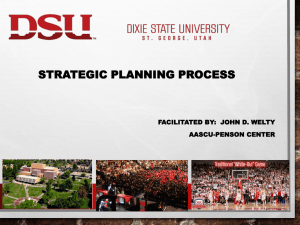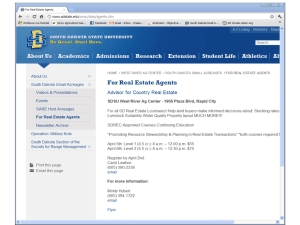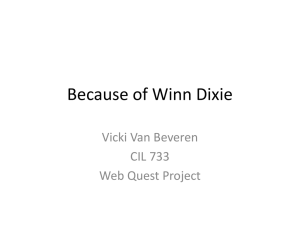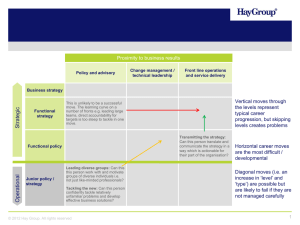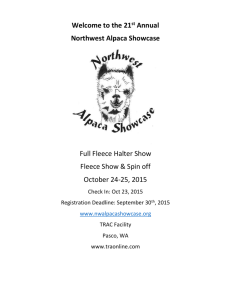Challenges, IEPs, and Routines
advertisement
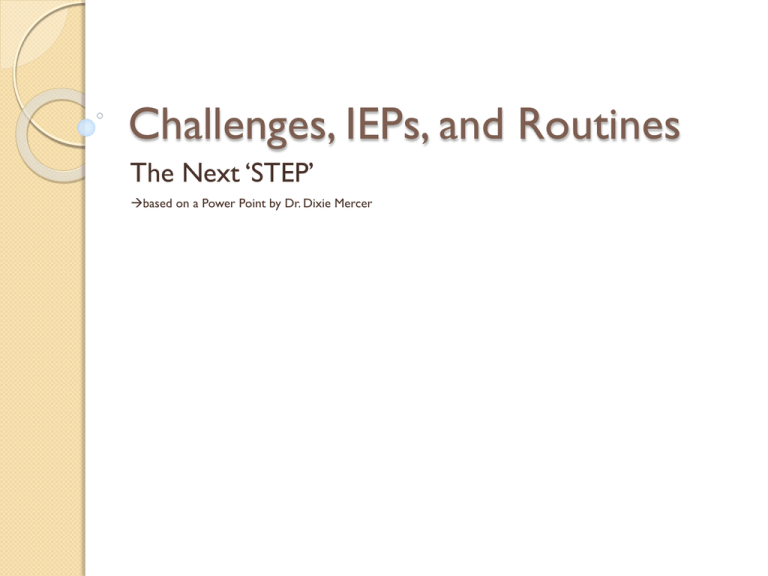
Challenges, IEPs, and Routines The Next ‘STEP’ based on a Power Point by Dr. Dixie Mercer STEP BY STEP Step 1: Preview Observation Step 2: Collection and Interpretation of Information Step 3: Observation Step 4: Foundation Interviews Step 5: Determination of Planning Category Step 6: Assessment Step 7: Determination of Strengths and Challenges Step 8: Development of Goals by a Transdisciplinary Team Step 9: Goals and Activities Input from Family Step 10: Development of Activity Based Routine Determination of Strengths and Challenges Step 7: Ideally done as a group. Specialists identify areas of particular strength and concern. Parents and teachers verify the existence of both. Step 8: Development of Goals Each PROFESSIONAL on the evaluation team develops one or two objectives to bring to ‘the table’. Goals for Dixie p.1 TVI PT Increase number of fixations. Strengthen her left knee. Increase frequency of environmental scanning. Increase upper body strength. Improve hand/eye coordination. Improve balance and flexibility. Goals for Dixie p.2 COMS APE Improve orienteering skills. Increase level of outside recreation. Improve ability to travel without a route. Decrease number of sedentary hobbies and activities pursued. PT/APE Dixie will: Improve in balance and flexibility as she participates in outside recreational activites. Increase strength in her left knee and upper body as she pursues hobbies and activities that require physical activity. TVI/COMS Dixie will: Increase frequency of environmental scanning as she travels from her desk to the computer lab without a route. To go from CHALLENGES IEP GOALS/OBJECTIVES ACTIVITY BASED ROUTINES 1. Look at all the environments in which the activities take place. 2. List the activities that take place in this environment. 3. List the steps in one Activity, to create an ACTIVITY BASED ROUTINE. 4. Go back through the steps of the ACTIVITIY BASED ROUTINE and ask: Does the routine include as many IEP objectives as possible? Is there any way we could include steps which would give the student more practice with any of the IEP objective skills? 5. Go back through each step and ask yourself: Can the student do this step without any adaptations or modifications? OK = Keep as is If not, can this step be eliminated without ruining the logical sequence of the routine? E = Eliminate Or, can this step be adapted? A = Adapt 6. Consider the Critical Visual Moment: At what points in the routine is it important for the student to use their vision? How can they be encouraged to do so? Go back through the steps of the routine and highlight each critical visual moment. 7. Data keeping: Design a simple data sheet to help you record progress on each IEP objective. Determine who will take data and when it will be taken. 8. Evaluate IEP progress: At pre-determined intervals, evaluate the progress that the student has made toward successful completion of their IEP objectives. Readjust as needed. So…let’s take the next step in developing an Activity Based Routine for Dixie. Family Activities Interview •Riding horses. •Caring for horses. •Showing horses. •Watching TV. •Playing computer games. •Playing board games. •Visiting with friends. Ask: “What would you like for us to teach Dixie, or what could we teach Dixie that would make your life easier?” To help with horse chores 1. Look at all the environments in which the activities take place. * * * * Barn Corral Pasture Tack room Choose one environment 2. List the activities that take place in this environment. Feeding Grooming Mucking out Saddling Select an Activity 3. List the steps in one Activity, to create an ACTIVITY BASED ROUTINE. Get the buckets. Go to the grain bin. Scoop the appropriate amount of grain for each horse. Take the buckets to the stalls or out to the corral. Dump the buckets in the feeding troughs. Go back to the feed bins and replace the buckets. Go to the hay barn. Get 2 chips of hay for each horse. Put the hay in the appropriate hay racks . Repeat until all horses have hay. Walk to the pasture. Halter each of the horses and walk them to their “feeding place.” Take the halter off. Close the gate. Walk to each water trough. Turn faucet to fill trough. Wait for horses to eat. Open the gates. 4. Go back through the steps of the ACTIVITIY BASED ROUTINE and ask: 1. Does the routine include as many IEP objectives as possible? 2. Is there any way we could include steps which would give the student more practice with any of the IEP objective skills? Dixie’s routine: Get the buckets. upper body strength and balance and flexibility Go to the grain bin. Scoop the appropriate amount of grain for each horse. strengthen left knee through walking and improve orienteering skills visual fixations and hand eye coordination and flexibility 5. Is each step OK as is OR does it need to be eliminated E = Eliminate, OR adapted A = Adapt? Go back to the feed bins and replace the buckets. OK Go to the hay barn. E -- Have Larry place the hay next to the feed bin each morning. Get 2 chips of hay for each horse. A -- Use a cart to carry the hay so she only has to make one trip. Put the hay in the appropriate hay racks. OK Repeat until all horses have hay. OK 6. Dixie’s Critical Visual Moments: Walk to the pasture. Halter each of the horses and walk them to their “feeding place.” flashlight aimed at buckle on halter Take the halter off. flashlight aimed at buckle on halter Close the gate. flashlight aimed at clip on gate chain Turn faucet to fill trough. Wait for horses to eat. international orange faucet handle Open the gates. flashlight aimed at clip on gate chain 7. DATA SHEET with who &when it will be taken. Student: Begin Date: End Date: Date: Activity: 1. 2. 3. 4. 5. 6. 7.


